#women in fisheries
Explore tagged Tumblr posts
Text
June 8 is World Oceans Day
so here are some articles about women I taking care of our oceans
https://today.ucsd.edu/story/scripps-led-fellowship-program-promotes-equal-access-for-students-interested-in-scientific-diving

“In an effort to make the diving community a more inclusive and diverse space, Scripps PhD candidate Erica Ferrer and then-PhD candidate Alyssa Griffin (now Assistant Professor at UC Davis) launched the SCUBA DIVERsity Fellowship Program at Scripps in the fall of 2022. They have worked alongside Scripps Director of Diversity Initiatives Keiara Auzenne and Scripps Dive Safety Officer Christian McDonald to create this fellowship program that provides undergraduate and graduate students with scientific diver training, access to gear, and even swimming proficiency lessons for those who have limited experience in the water.”
#June 8#world oceans day#Women in Science#Sonya Legg#center of Ocean Leadership#great barrier reef#Sea Women of the Great Barrier Reef#Australian First Nations women in marine conservation#Sea Women of Melanesia#Catherine Cat O’Keefe#New England Fisheries Management Council#Guyana
38 notes
·
View notes
Text
Eunice Auma's Journey: Leading the Charge for Women in Fish Farming in Homa Bay County
Discover how women in Homa Bay County are transforming the fishing industry through cage fish farming, breaking free from the traditional “jaboya” practice and leading Kenya’s blue economy revolution. Learn about the inspiring journey of women in Gwassi Ward, Homa Bay, as they rise to become fish farmers and entrepreneurs, driving economic empowerment through sustainable cage fish farming on Lake…
#aquaculture#aquaculture practices#blue economy#cage fish farming#community development#economic independence#economic transformation#financial inclusion#fish farming initiative#fish farming success#fish farming training#fish market access#fish production#Food security#gender equality#Homa Bay County#investment in women#jaboya#Lake Victoria#local fish trade#Rasira Women Group#skill development#sustainable fisheries#sustainable livelihoods#women empowerment#women entrepreneurs#women in agriculture#Women in Fish Farming#women-led projects#women&039;s coalitions
0 notes
Text
NITI Aayog announces revised composition.

New Delhi: The National Institution for Transforming India (NITI Aayog) has unveiled its revised composition, aimed at enhancing its strategic leadership and effectiveness. The Indian government has reconstituted the National Institution for Transforming India (NITI Aayog), with Prime Minister Narendra Modi remaining as the chairperson and economist Suman K Bery continuing as the vice-chairperson.
ALSO READ MORE- https://apacnewsnetwork.com/2024/07/niti-aayog-announces-revised-composition/
#Amit Shah home#Annapurna Devi Women and Child Development#Arvind Virmani#Chirag Paswan Food Processing#H D Kumaraswamy Heavy Industries#J P Nadda Health#Jitan Ram Manjhi MSMEs#Jual Oram Tribal Affairs#K R Naidu Civil Aviation#National Institution for Transforming India#Nirmala Sitharaman Finance#NITI Aayog#NITI Aayog announces revised composition#Nitin Gadkari Road Transport and Highways#Rajiv Ranjan Singh Fisheries#Ramesh Chand#Rao Inderjit Singh Statistics and Programme Implementation#Shivraj Singh Chouhan Agriculture#Union Minister Rajnath Singh#VK Paul#VK SaraswatVirendra Kumar Social Justice
0 notes
Text

Four culturally significant aquatic birds in Imperial Wardin- the skimmer gull, the albatross, the reed duck, and the hespaean.
The skimmer gull is a small seabird, distinguished by bright red beaks and a single, trailing tail plume. These are sacred and beloved animals with a long history of symbiosis with local fishers. They will intentionally attract the attention of fishermen, bringing them to shoals of fish that are too deep below the surface for the birds to reach. They then will snatch fish fleeing or caught in the nets, and will often be directly fed by their human assistants in an act of gratitude. They benefit tremendously from their sacred status and a taboo against killing or harming them, and can become absolute food-stealing menaces in seaside towns and cities.
The albatross is a seasonal visitor to the region, with this population migrating to small rocky islands in the White Sea to breed. The specific species occurring in this region is on the smaller side, and has a pale pink beak and soft orange legs. Albatrosses are common characters in regional animal folktales (usually as foolish, romantic types), and sometimes appear in tales as shapeshifters, usually turning into young women who have tumultuous affairs with lonely sailors.
Skimmer gulls and albatross are the most sacred animals of Pelennaumache, the face of God which looks upon the ocean, the winds, storms, maritime trade, fisheries, and broader concepts of luck and the infliction and deflection of curses. Killing either of these birds is considered to bring about disastrous bad luck (unless in the context of a proper sacrifice, most commonly in rites to bless ships and/or sailors with good winds and against ill fortune). The eggs of skimmer-gulls are free game and considered delicacies, while the preciousness of the albatross' single egg clutch is recognized and their consumption is generally discouraged (this isn't to say it doesn't happen).
Feathers of rightly sacrificed albatross and skimmer gulls are minor holy relics (ESPECIALLY gull tail plumes), and considered to be the ultimate good luck charm. The fortuitous find of a shed feather can also impart good luck and can be very valuable (the birds are sometimes poached for their feathers, though fears of the consequences are enough that this poaching is limited in scope). You will often see wealthier people wearing the feathers in hats and headdress, and any seafaring vessel worth its salt should have at least one aboard.
Both birds are evoked in the apotropaic Skimmer-Woman motif (in practice it generally has albatross characteristics, though is sometimes depicted with the tail plume of the gull).
The hespaean is a very unusual bird with two distinct species native to the region, one found exclusively in the western Black river system and its estuaries, and one found in the eastern Brilla and Kannethod river systems. They have very small pointed teeth in their bills, a trait virtually unknown outside of the flightless, beakless classes of birds (most prominently qilik). Their wings are vestigial and virtually nonexistent (with only two bony spurs remaining). These birds are almost exclusively aquatic and do not normally emerge onto land (they cannot walk upright at all, and must push themselves on their bellies). The legs of the Black river hespean develop blue pigmentation from their diet (the brighter the blue, the better fed and healthier the bird), which are waved above the surface during elaborate courtship displays. Both species are known for their haunting, warbling cries (very much like a loon, but more of a howling noise that develops into a shrill warble).
Hespaean build their nests in dense beds of reeds or small, vegetation-heavy river islands that provide some protection from predators. They raise their young during the height of the dry season (when more nesting surfaces are available and they can feed their young with more concentrated fish populations), which is an image of hope and resiliency during harsh dry times and the promise of the river's eventual bounty.
It is known that hespaean used to be caught as chicks and raised to help people catch fish (with ropes around their necks to prevent them from swallowing their catch). This practice is now very rare in the Imperial Wardi cultural sphere (mostly still practiced by the Wogan people along the Kannethod river, to whom these birds are also venerated animals) and has been largely replaced with the import of domesticated cormorants from the Lowlands to the southeast (which are more easily trained and can Usually be trusted not to attempt to swallow their catch).
These birds require large rivers that flow year round and have healthy, dense fish stocks. The population is in decline and they are now relatively rare, largely due to development and overfishing around rivers (and on a much larger timescale, the region becoming drier and water levels more irregular, and their competition with more versatile freshwater tiviit).
The reed duck is a migratory freshwater duck whose coming heralds the beginning of spring growth. They come to mate along rivers and wetlands during the early stages of the wet season, timing their eggs to hatch with the rise in water levels and growth of the vegetation and insects they feed on. They have striking red-brown and gray plumage and very little sexual dimorphism (though the male is somewhat brighter in color and the flesh around the bill turns bright red during the breeding season).
Reed ducks are not domesticated, but some populations are semi-tamed and encouraged to return to certain sites to breed (the riverside temple to Anaemache in Ephennos attracts a massive flock of the ducks every year, continually blessing it with their presence and coating its grounds in droppings), and these stocks are the primary source of sacrificial ducks and coveted shed feathers.
Hespaean and reed ducks are the most sacred animals of Anaemache, the Face of God which looks upon freshwater (particularly rivers), rains, seasonal flooding, fertile earth/seasonal fertility, and wild plant life.
The hespaean is representative of Anaemache as the River Itself and the river as a provider of fish. This association comes down to their all-seasons presence in the rivers, and their population density being a signal of a healthy, well-flowing river with good fish stocks. Lands adjacent to hespaean territory is often the most reliable and bountiful for human subsistence.
The reed duck in particular is the most venerated sacred animal of Anaemache, as representatives of Anaemache as a Face of seasonal fertility. Its coming announces the rains that the region's agriculture relies on, and their cycle of fertility closely matches the cycles of the rivers and that of the earth itself (with their new life emerging with rains, flooding, and new vegetation). There is no prohibition on hunting reed ducks (though proper rites and respect are expected for a sacred animal), and their meat and eggs is said to support female fertility and a healthy pregnancy.
#Hespaean are what I've been repeatedly misspelling as hespiornis up until now (got kind of lazy with the 'hespaean' name but the -an root#is established and makes sense). They're derived hesperornithes that have survived up to the present day but near exclusively as#smaller freshwater birds (their larger marine counterparts have been mostly displaced by tiviit and uhrwal)#Hespaean species exist outside of this region and have a worldwide (but highly fragmented and isolated) distribution#creatures
211 notes
·
View notes
Text
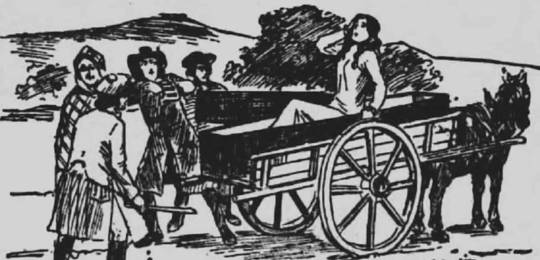

September 2nd 1724 Maggie Dickson climbed the gallows in Edinburgh's Grassmarket, ready to take “The last drop”
Her downfall came when she got pregnant and tried to conceal the fact. Maggie’s husband had deserted her to work in the Fisheries in Newcastle in Northern England.
Consequently she had to leave Edinburgh and moved to Kelso in the south of Scotland. Whilst there she had an affair with an innkeepers son.
As the Innkeeper was her employer she felt compelled to keep the pregnancy quiet as she would lose her job. Tragically the baby died after being born prematurely and she decided to dispose of the body. She intended to cast it into the River Tweed but instead left it on the riverbank. It was soon found and the authorities quickly determined that Maggie was the mother. At that time such an action in Scotland contravened the 'Concealment of Pregnancy Act' of 1690 which made it tantamount to murder.
"Her reason for concealing the birth of the child was for fear of being made a public example in the church, and a laughing-stock to all her neighbours The legal and religious institutions were severe on women concerning matters of their pregnancy. Even the natural occurrences of miscarriage or still-born infants could incur the wrath of the law.
And so it was, Maggie was tried, convicted and sentenced to hang. The execution took place on the 2nd September 1724 in the Grassmarket area of Edinburgh. This was the favoured location for hangings at that time and normally took place on market day to ensure a sizeable crowd.
Her body was then taken in a coffin for burial to the town of Musselburgh which was east of Edinburgh. Apparently this was only after an unseemly scuffle between her family and local medical students keen for a young body to dissect. The corpses of the condemned were regularly passed to the Schools of Anatomy in the name of science in the 18th century.
The family had their way and took possession of Maggie's remains for burial. They set off on the journey and on the way stopped off at a pub for some refreshments in the Peffer Mill area. All of a sudden there came a knocking and banging on the coffin lid from the inside. Astonished, they opened up the coffin to discover that she was not dead.
Miraculously it seemed that Maggie Dickson had not succumbed to the gallows but had cheated death at the hands of the law. She was alive and well as confirmed by a local gardener on the scene who cut a vein to check for a flow of blood. After spending a night to recover Maggie actually walked back to Musselburgh the next day.
But what would happen next? As the death certificate had already been issued it was impossible to re-execute Maggie. This was because Scots Law is based on Roman Pandects and in this case it prohibited further action. Therefore the King's Advocate could not pursue the matter any further.
Instead he filed against the Edinburgh Sheriff in the High Court of Justiciary for not efficiently conducting the public execution. The ruling also meant that as Maggie was technically dead then her marriage was dissolved.
Furthermore, the prevailing opinion amongst people in Edinburgh considered her survival to be the result of divine intervention. Local people believed it had been 'God's will' that had spared her from an early grave.
Rumours persist that she actually seduced the ropemaker and convinced him to make the noose weak enough not to kill her. We will never know if that's the truth.
Whatever the facts of her hanging Maggie lived for another 40 years and had many children. Her husband remarried her despite that fact that she now sported rope burns and her neck was permanently crooked for the rest of her life. She is said to have ran an alehouse in Musselburgh for the rest of her life.
If you have ever visited Edinburgh’s Grassmarket you will have no doubt seen the names of the bars have a historical connection, The White Hart connects with King David I and his encounter with a White Stag, The Last Drop is of course a nod to the execution place and Maggie Dickson is for our erstwhile subject today, who the people of Edinburgh remember as “ Half-hangit Maggie “
56 notes
·
View notes
Text
Excerpt from this story from The Revelator:
News
Extinction Countdown
Investigations
Wildlife
Climate Change
Oceans & Clean Water
Pollution & Toxins
Public Lands & Protected Spaces
Sustainability
Ideas
Voices
Editorials
Op-Eds
The Ask
Podcasts
Culture
Reviews
Book Excerpts
Arts
About
Subscribe
As a legislative policy fellow and anthropologist who studies women’s well-being in coastal communities of Chile and Indigenous salmon management in Alaska and Canada, I’ve witnessed how genocidal attempts to eradicate Indigenous peoples and their cultures have also damaged the environment. We see it in current management’s low returns in fish, high levels of runoff and nutrient input into ocean systems, and generally unsustainable levels of resource extraction.
I’ve also seen the opposite: I interviewed managers and biologists in Vancouver, Canada, who described the substantial improvements of Indigenous-led, bottom-up approaches to conservation. They see fish return and people fulfilling their well-being and nutrition needs. They see political and economic reform and a revitalization of social and cultural practices.
Unfortunately this is still not the norm, as we saw in a recent international agreement between the United States and Canada that placed a seven-year fishing moratorium on Chinook salmon to encourage fish populations to rebound. Most people would agree that this is a worthy goal for the conservation of both the species and the people who depend on Chinook. However, the new agreement fails to factor in Indigenous access to resources for ceremonial and subsistence harvest, which is mandated by law, nor did legislators acknowledge public comment that supported that access.
The marginalization of Indigenous peoples today, as seen in this agreement’s failures, can be traced back to colonialism.
The history of colonialism is steeped in human-rights violations such as the outlawing of Indigenous salmon-management practices that settlers later appropriated for their own economic gain. Settler wealth was achieved only through the exploitation of resources and forced relocation of Indigenous peoples out of economically advantageous spaces and acculturation into oppressive colonial ones.
“Settler governments [are] primarily concerned with economic gain,” a British Columbia-based project manager focused on salmon restoration told me during an interview. “Their mandate is to work commercial fisheries or recreational ones that generate economic value for their states, provinces, or countries…That’s the starting point; when human well-being is the starting point — like it is with Indigenous people — then it leads to a very different kind of management.”
20 notes
·
View notes
Text
Kagurabachi theory part 2
In my previous post I talked about my thoughts about the allusions to gods in Kagurabachi, and I mentioned that 7 Enchanted swords could be a vague reference to the 7 prosperity gods. And now I want to talk further about the swords.
Part two. The Enchanted Swords and what makes them special.
At first, I thought that the swords could be a further reference to the different prosperity gods, as Enten summons goldfish and Ebisu is the god of fishery.
This could also tie into the title of the story if the swords have something to do with the gods. Kagura dances often are accompanied by props, and fighting is often associated with dancing.
Meaning that possibly every time Chihiro uses Enten to dance/fight, he invites the (power of the) gods in his bodies.
Then, when I thought it through, I think that I found another connection:
All swords, until now, have a potential link to yokai/mythological creatures.
Enten summons goldfish, and there is a Yokai, Kingyo no yurei, which are goldfish possessed by spirits of the deceased, often murder victims.
Cloudgourge gives ice, water, and lightning abilities and sometimes summons attacks in dragon forms. Dragons in Japan are associated with water and the weather, so that tracks.
Tobimune has summoned feathers in a move called 'Crow/Karasu', and Tengu are a Yokai based on crows.
Kumeyuri has not revealed much about it, just some geisha-like spirits, however, there are enough Yokai that are based on normal-looking women. Yuki-onna, kuchisake onna, Ame-onna etc. I will have to see more to determine (if true) which yokai it is precisely.
The last revealed sword is Magatsumi, which has references to multiple yokai. It creates flowers and butterflies through spider (Jorogumo), dragonfly (koshinuke no mushi), and centipedes (omukade) techniques.
However it could also be a reference to a single yokai: the Jubokko, a vampire tree that consumes all your blood and is associated with insects that will take care of the carcass that is left. It could also explain the black liquid, as blood can become near black the longer it coagulates.
(A Jubokko would also be kind of ironic considering these trees are created when a huge amount of people died at their feet. And wouldnt you know, there was a war going on at the very moment Magatsumi was created.)
We have not seen the other swords, so everything is still possible, however, my theory for now is that the essence of yokai has been in one way or another placed/forged into the swords (hence why they are called Yoto, demon swords).
The first swords contained 1 yokai each, however those swords were just not strong enough. So the 6th sword was forged with either 3 yokai in it to make it more strong, or 1 yokai that could be stronger the more it is used in battle/gets blood.
This theory could also be why Magatsumi had to be sealed away so carefully compared to the other swords. It was already so powerful due to the 3 yokai that nobody should wield it in fear of damage/being corrupted by the yokai.
Or because if it continued to be used it would eventually get so strong that anyone wielding it would be overcome by it.
(If this theory is true, Enten could become an interesting plot point later, as Chihiro's father was murdered, so he could be in the sword.)
TLDR; The demon swords can possibly contain demons. Who could have thought?
(More thoughts in Part 3: Sealing power)
#kagurabachi#magatsumi#tobimune#kumeyuri#Cloudgourge#Enten#Kagurabachi theory#fan theory#chihiro rokuhira#theories#speculation#kunishige rokuhira
15 notes
·
View notes
Text
Women have played a vital role in agriculture since prehistoric times, contributing to the development of technologies and processes for harvesting and preparing food. However, their contributions are often under-recognized.
https://www.idahofarmbureauinsurance.com/protecting-your-world/the-history-and-rise-of-women-in-agriculture/#:~:text=Records%20show%20that%20women%20have,be%20assets%20in%20the%20field.
The true extent of women's work in agriculture is often not fully recognized or recorded. The number of female farmers increased dramatically during World War II when men were called to fight overseas.
Research shows that since about 10,000 B.C., women have played a part in how we source and harvest our food. Unfortunately, there isn't too much data on them – in some ways, they're silent contributors. The number of female farmers surged during the 1940s, as men went off to fight in World War II. Women are the backbone of agriculture, making significant contributions to crop production, livestock management, fisheries, and forestry
https://www.resilience.org/stories/2020-01-30/the-rise-of-women-in-agriculture/#:~:text=Research%20shows%20that%20since%20about,fight%20in%20World%20War%20II.
12 notes
·
View notes
Text
1890-1891 Interlude
(CW: Pregancy and loosely described childbirth)
Rosalie grew ever more excited with each passing day. A baby born in America would be very lucky indeed. It would be allowed to learn to read and write, an option forbidden to her and Toulouse. Their baby would not have to tell fortunes or steal horses for a living. Their baby most definitely won't wake up to a fire surrounding it because gadje didn't want it there. No her baby was more lucky than any other. How many opportunities do gadje take for granted? Plenty, in her honest opinion.

Turns out she wouldn't actually be alone in this venture either, for their closest neighbors were also expecting a child. Mila's baby was further along than Rosalie's but that didn't matter. With both their husbands working for Slade Gorton & company fisheries, the women had formed a close bond. They were often over at each others houses, especially after church.


Just because she was now with child, didn't mean that Rosalie could laze about the apiary. There were candles as well as mead to be made with the excess honey and wax, to sell in the coming winter months. The bees were the first things other than her husband that she told about her pregnancy. Hr mother had said that they should know about such events as births and deaths, and to not tell them would be seen as rude and make them fly away.

One night in January 1891 when Toulouse was home, Rosalie started to feel subtle pains that reminded her of the cramping of her monthly curse. She didn't think nothing of it. Just brought the laundry in off the line and went to sleep. That is until she was awoken by the increase in ferocity of these pains. The baby was coming and coming too fast for Toulouse to run to the Reeds.


Even though it wasn't proper by their culture and in general, Toulouse stayed by his wife's side as she gave birth. They were the only gypsies in Brindleton and the only people left of their baro. So Toulouse labored with his wife all through the night until finally at dawn on the first of February 1891, they delivered a fine beautiful baby girl.
Rosalie had not thought of a name for the child but instantly one came to her. The bees that had brought them so much luck and prosperity in America... Abeille.

***
Previous / Start / Next
Yay she is born! it seems like every time I try this legacy their first born is always a girl. At other times in my more modern gameplay it's always a boy!
Toulouse was breaking convention both for the time period and for cultural reasons. Most men didn't attend their babies births, and romani people leave the mother alone for three days because that is a time where she and the baby are considered most marime or "polluted". Babies and children in general are considered wuzho until puberty but because babies emerge from the most marime part of the body (the genitals), they are consider impure for 3 days after birth. However, since Toulouse and Rosalie are the only Romani in Brindleton and what is left of their Baro, Toulouse decided to stay with his wife. I think after this he goes on short leisure fishing trips with Mr. Reed.
The baby's name is the French word for Bee "Abeille". Here is how to pronounce it. Sort of like Abby but the end is different. Also Pelletier is pronounced the french way too:
youtube
Not like in this version:
youtube
#the pelletier legacy#rosalie pelletier#toulouse pelletier#Abeille Pelletier#1890s#ts4 decades challenge#decades legacy#sims decades challenge#sims 4 decades challenge#the sims#the sims 4#ts4 legacy#legacy founder#ts4#ts4 simblr#simblr#Youtube
12 notes
·
View notes
Text
Since my friend and I are playing Bioshock 1, i wanted to share some of the things that have happened so far:
- We sat and watched the plane fully sink
- "OUGH?!" < her reaction to the giant Ryan statue
- Right off the bat she didn't trust Atlas and said his wife and child aren't real
- Every security bot is named Jeff
- The wrench is also Jeff(rey Bezos)
- We spent 30 minutes trying to get to Steinman because I forgot I has to throw the bombs at the debris blocking the entrance
- We went through 4 nitro splicers before I realized something wasn't right. I do this everytime. I literally replayed Bioshock like 2 weeks ago and forgot how to do that
- I've died more times in this playthrough than I ever have in Bioshock 1
- Keeps asking me if Atlas is evil, I keep telling her no and that he's my babygirl
- I've been spoon feeding her Atlas propaganda so hopefully she'll trust him by the end
- LOVES the little sisters, terrified of big daddys. She screamed the first time we had to fight one
- I tried to get the first bouncer stuck behind the register in the Medical Bay, but absolutely shredded him before I could
- The women were too stunned to speak
- We sat under the floor of the McCracken Crab trying to kill a Rosie. I died.
- I also hid under the floor of the Fisheries and smacked Splicers that walked overhead
- I got killed by a (different) Rosie like 5 times before I finally killed her
- Also ran from the third Rosie repeatedly before I finally killed him
- She chose target dummy for our first real plasmid
- I've only ever used it when losing control of the plasmids. So I've only used it once-
- Me: God I hate Andrew Ryan
Her: Bash his brains in
Me: *Hephaestus flashbacks* Oh I'm gonna
- Spider splicer: *angry screeching*
Me: New wife for you
Her: Great, thanks
- Hates it everytime I say "Snappies"
- I spent way too long looking for the final spider splicer before realizing I could take a picture of a dead one
- She did trust Peach Wilkins though (Somehow??)
- "I've got a really bad feeling about this" intensifies
- Yelled "THIS IS YOUR MAN⁉️" When Atlas walked out and almost missed Ryan's speech and the splicers bc of it
- Predicted the sub would blow up, but was shocked when it actually did
- I think she begrudgingly trusts Atlas now, his acting is peak
- I also went on a 2 minute rant about him and she made fun or me the entire time
- *finds a crawlspace full of Atlas posters*
Me: Oh my god, this is where I live!!
Her: NO
Me: With my Atlas posters and my.. Pistol bullets??
Her: N O !!
- #1 Langford stan (she's in love with her)
- Got jumpscared by the Houdini splicer that appears behind you (We both screamed)
- I was laughing bc his shadow was looming over us, then slowly turned around and we had a staring contest before I finally shot him in the face
- I've literally never seen him just sit there before?? He always disappeared as soon as I turned around. Wild
- She compared Langford writing the code on the window to 11307 from Danganronpa (iykyk)
- Cue disappointed sighing (Not really, I laughed really hard)
- This entire playthrough has just been me aggressively hitting on Atlas and her reevaluating our friendship
- Not even the posters are safe
- "Who is Atlas?"
Me: My husband
Her: UGH
- Saying "This is for me!!" every time I see an Atlas poster
- She is genuinely considering killing me
- Made me harvest a little sister to see what would happen 😔 We reloaded tho it's okay
- I've found so many secrets in this playthrough, including a vent that goes to a meat locker in the Farmers Market
- It felt like I was getting chased by everyone in Rapture while trying to make the Lazarus Vector
- I also (somehow) shot the big daddy in Langford's office while fighting splicers
- That was terrifying
- *Enters Fort Frolic* Me: It's about to get real silly
- I've been hyping up Cohen this entire time because I knew she would like him
- Unfortunately, she does
- She gagged at the "expectant mama" line
- Got jumpscared AGAIN by the splicer in the basement of Sinclair Spirits
- "SINCLAIR WHAT THE FUCK"
- I can never find the record store when I play Bioshock, this time was no different
- I gave up and went after Hector instead
- When we met Silas Cobb she yelled "KITTENS??"
- She agrees Silas is a discord mod
- We spent like 2 minutes straight trying to catch Hector and Silas
- I also got jumped by a bunch of splicers every time I tried to kill a bouncer
- She lost it at Cohen walking down the stairs
- "HIS GAY ASS WALK"
- I smacked Cohen after his speech and immediately ran
That's all so far, but we'll hopefully play some more this week!
#im just waiting for the reveal bc shes gonna judge me SO hard#i dont think she even knows who fontaine is#if we play bioshock 2 im gonna try to make her distrust sinxlait#>:)#maximun pain#atlantis.txt#bioshock#bioshock 1#atlas#jack wynand#sander cohen#julie langford#andrew ryan#silas cobb#martin finnegan#kyle fitzpatrick#hector rodriguez#bioshock disciples#peach wilkins#js steinman#frank fontaine#spoilers#bioshock spoilers
110 notes
·
View notes
Text
last night, during the street outreach, we had a woman come up to us, incredibly agitated that the undercover footage we were showing of slaughterhouses and dairy, egg, and fishing industries was visible to children.
two of the activists had brought their healthy, intelligent, wonderfully well-adjusted vegan children, who have both previously seen the footage with their parents and asked questions and received honest answers.
and i approached her to ask her—if she cared so much about the welfare of children, as she claimed, why was she not boycotting these industries?
if you are against child labor in any real way, you WOULD boycott industries that require labor in slaughterhouses, meat-packing facilities, fisheries, egg farms, dairy farms, fur and wool farms.
because guess who makes up a significant portion of that labor? CHILDREN. illegally and legally both, depending on the state or regional laws.
i’ve seen it with my own eyes at slaughterhouses, up close—i’ve seen children no older than 12 made to haul the dead bodies of pigs, still bleeding. i’ve seen them working in those farms.
there are innumerable minors “employed”—or enslaved—to animal agriculture and the resultant slaughterhouses and meat-packing and chick-grinding and animal skinning. PTSD doesn’t even begin to cover what these children come home with. to say nothing of how unsafe these jobs are��would anyone like to look into how many injuries and outright limb amputations are caused by slaughterhouse work each year? cuz it sure isn’t zero.
do you think Big Meat insures their workers and pays for medical bills and a pension when these incidents occur? how much do you think they care about safety code violations? the USDA and ASPCA approved slaughterhouses i’ve seen in person are in violation of at least 40 codes, minimum.
and let’s talk about the field farming of the immense amount of food required to sustain the animals imprisoned within these industries—lest we forget, most of the world’s food and calories go to feed these animals, not us.
and guess who they rely on most to farm that animal feed.
these industries will ALWAYS find a way to use children for their labor, because it’s cheap and it’s easy. they will NEVER stop using child labor. ever. it doesn’t matter how many laws are “in place”—these places will always get away with it bc they literally cannot exist without extensive and wildly cheap labor. you cannot invent an animal agriculture that won’t find a way to silently exploit minors for cheap labor.
these businesses are at the top of the capitalist heap—it’s a business that, once again, cannot exist without human slavery on a large scale, with much of that burden resting on children and immigrants (particularly women, btw).
if you actually care even a little bit about child labor, really, one of the most effective things you can do is to boycott animal product industries.
#unethical labor is why your meat is so ‘cheap’ btw#one reason at least. govt subsidizing of these slavery farms definitely help#but the less they have to pay their workers who are in high risk jobs the better!#guess what the slaughterhouse overturn is for employees btw!#and guess what kinds of psychological trauma and long term issues they leave with#v#vp
24 notes
·
View notes
Text
The Real Women of Petticoat Row
An article in The Inquirer and Mirror put it in 1976, “Petticoat Row has been the nick-name of Centre Street from Main Street north towards Broad Street since the 18th Century, so called because the shop keepers were mostly ladies, usually the wives or widows of the men who were away for years at a time with the whale fishery.”
This is only half true when talking about the ladies of Nantucket, because the famous Petticoat Road only got its name in the 19th century. In this wonderful work, Michael R. Harrison has recorded the history of these ladies and examined several of them in detail. Highly recommended to read.
#naval history#petticoat road#whaler#women at sea#18th century#19th century#history#age of sail#age of steam
49 notes
·
View notes
Text
A Rude Rescue
for @logarithmicpanda
a little fic for the kkc fandom
When Fela saw Ambrose had cornered a girl outside the Medica, she knew she had to intervene. She took a deep breath, threw back her shoulders, and channeled all the false bravado she could find.
"There you are," she said breathlessly, running up to the girl. She looked young, with her long brown hair, big brown eyes, and thick brows. She gently placed her hand on the girl's arm, her face turned away from Ambrose, acting as though he had interrupted their conversation instead of her rude rescue. "I have been looking everywhere for you! We need to head down to the Archives."
The girl's face lit up in relief and took Fela's hand in hers. They could hear Ambrose objecting as they raced off.
They stopped to catch their breaths around the Fishery when the girl broke out laughing. "You should have seen the look on his face. He was fuming!!"
Fela couldn't help but laugh along. "I've been cornered by him before, I figured I would assist you in escaping."
The girl smiled widely. "My knight in shining armor. You read the scene well."
Fela blushed, feeling her heart skip. She quickly changed the subject. "Are you new here? I haven't seen you around. I know all the women who study here by name at least."
The girl looked startled. "No, I never learned well in a classroom. I was just a little curious. I wanted to see what the fuss was about. And then Ambrose saw me and wanted to 'catch up.'" She made a face. "I was looking to make an exit when you appeared."
Fela looked down. "I know too many people he has hurt. I was hoping to avoid another."
She felt a hand on hers. "That is quite kind of you. And brave."
Fela felt herself blush again fron all the flattery. "I could show you around, if you'd like. Most of the company is better than Ambrose." She paused to consider. "Actually, all of the company is better than him, come to think of it."
The girl laughed again, loud and clear. "I would like that. I've found being here has only inspired more questions than answers. The first of which is the name of my mysterious rescuer." The flirty tone of her voice was unmistakable and this time, Fela wanted to flirt back, but was much out of practice.
"I'm Fela," she said. "What should I call you?"
The girl held her gaze for a moment. "Dinae. You can call me Dinae."
#kkc#carrie writes stuff#my fic#uhhh i might add more but my shift is in an hour#wanted to write this down asap
17 notes
·
View notes
Text


16th July 1832 was a very sad day on Shetland when tragedy struck .
On tis day 31 Shetland "sixerns", the traditional fishing craft of Shetland and a total of 105 crewmen were lost in a storm.
There were between 300 and 500 sixareens or sixerns in Shetland. The Haaf fishing proved to be a hard life for these boats and they only tended to last 5 or 6 years. When they finished their lives as a fishing vessel some ended up being used as a flit boat for moving livestock, peats and other goods between islands or from ship to shore. The sixareens may eventually have ended up as the roof of shed or outbuilding. Nothing was ever wasted in Shetland, especially if it was wooden!
The men would travel up between 20 and 40 miles offshore. As the men were dealing with a prevailing wind, they could usually only sail in one direction. They were always happier if they could row out with a relatively light boat and sail back with a heavy load of fish!
When they reached the fishing grounds, the fishermen would barely be in sight of the highest hills in Shetland. They would have sea all around them.
Haaf fishing was very dangerous due to the unpredictable nature of the weather far out at sea. However, when you look at the numbers of men that fished and the length of time that they fished for, the actual disasters are relatively few.
On 16 July 1832 31 Shetland "sixareens" and a total of 105 crewmen were lost in a storm. The event is still remembered as "The Bad Day". A London Distress Fund was set up and raised the sum of £3000. The money was raised for the dependants of the crofter-fishermen lost. The crew of one boat in 1832, did manage a lucky escape from the storm as they were picked up by a passing American sloop. However, the Captain of the American vessel refused to alter his course to Philadelphia and so, despite passing close to Orkney, the survivors had to cross the Atlantic and endure a further six months away from home before returning.
During another storm on 20th July 1881, hurricane force winds caught the fishermen by surprise. The boats that tried to come home were mostly capsized or swamped, but those that stayed at their lines for the most part survived. In all ten boats foundered and 58 Haaf fishermen lost their lives. They left behind 34 widows and 85 orphans. Six of these boats and 36 of the men were from the fishing station at Gloup in North Yell. It was a tragic loss for a small community.
On the morning of 21st December 1900, boats from Firth, Mossbank and Toft set off for the winter haddock fishing. They were some 32 kilometres (20 miles) away, between the Horse of Burravpoe and Da Snap, when they were caught in a sudden and severe gale from the north-west.Many were lost during the storm which came on in the space of five minutes. The fleet were scattered. One made it to Whalsay, Skerries and Lunning but the rest were lost.
22 men were drowned, leaving 15 widows (5 of whom were pregnant), and 51 children. Firth was hit the hardest. Many of the men were great fishermen and the disaster devastated the Delting fishing industry, which never recovered. The women continued to work the crofts. Children grew up and moved away, leading to a rapid decline in population.
The plight of the families left destitute led to a lot of publicity in local and national press. The Delting Disaster Fund was set up to help those affected and it was one of Queen Victoria’s last public acts to appeal for support
These major fishing disasters signalled the beginning of the end for Haaf fishing. The herring fishery in the 1880s and the Crofter’s Act of 1886, which put an end to the truck system, were two more nails in its coffin.
Larger safer boats were introduced and undecked sixareens were replaced by fully decked smacks. Fishermen could finally install a few home comforts. However, when the steam trawler was introduced, longlining in large sailing boats couldn’t compete economically. Haaf fishing stopped quite quickly at this point.
There are few sixareens left in Shetland, a couple of replicas and bits and pieces lying around here and there. At the Shetland Museum and Archives there’s a replica sixareen called the Vaila Mae. She sails regularly in Lerwick Harbour and you can even get a trip on her during Shetland Boat Week!
One of the only surviving sixareens from the past can be seen in the Shetland Museum. She was built as the Foula mail boat, which fished for a little while and then ended up as a flit boat for shifting peats. She didn’t spend much of her life as a fishing sixareen.
You can find memorials all over Shetland to those lost at sea not just for the tragedies I have mentioned today but all in general, the Shetland way of life having strong heritage links with the sea that surrounds it.
16 notes
·
View notes
Text
Holidays 9.21
Holidays
Arbor Day (Brazil)
Battle of Kulikovo Day (Russia)
Biosphere Day
Bleeding Hearts Club Day
Celebration of Honors (French Republic)
Celu Press Freedom Day (Philippines)
Commemoration of th Declaration of Martial Law (Philippines)
Customs Service Day (Poland)
Daily Newspaper Day
Day of Inventors and Innovators Day (Ukraine)
Devil’s Nutting Day (UK)
Do You Remember Day (the 21st night of September; Earth, Wind & Fire)
Earth, Wind & Fire Day
Eleven Days of Global Unity, Day 11: Peace
Emoticon Day
Escapology Day
Farm Safety Day for Kids
Feast of the Ingathering (UK)
Founder's Day (Ghana)
George Harrison Day (Illinois)
Get Out Of Town Day
International ‘Ask a Satanist’ Day
International Biodiversity Day
International Day of Peace (UN)
International Day of Progressive Rock
International Day of Struggle Against Monoculture Tree Plantations
Kwame Nkrumah Memorial Day (Ghana)
Long Count Day
Medusa Asteroid Day
Miniature Golf Day
Myositis Awareness Day
National Brittany Day
National Cat & Dog Gut Health Awareness Day
National Day of Civic Hacking
National Day of the Radio Broadcasting Worker (China)
National Deaf Dogs Rock Day
National Disaster Prevention Day (Taiwan)
National Farm Safety Day for Kids
National Fisheries Day (Thailand)
National Garage Condo Day
National Gymnastics Day
National Hannah Day
National Imperfection Day
National Kristina Day
National Myositis Awareness Day
National New York Day
National Opioid Awareness Day
National Radio Day (Chile)
National Singles Day
National Surgical Technologists Day
National Volunteer Day (Ghana)
Observe the Speed Limit Day
Pause the World Day
Peace One Day
Pharmaceutical Worker’s Day (Ukraine)
Secret Note Day
Spring Day (a.k.a. Student’s Day; Argentina)
Sree Narayana Guru Samadhi Day (Kerala, India)
Student’s Day (Argentina; Bolivia)
Telegraph Pole Appreciation Day
Throw Something Away Day
Victory Over the Golden Horde in the Battle of Kulikovo (Russia)
Volunteer Day (Ghana)
Watticism Day
World Alzheimer's Day
World Day of Pagan Pride
World Day of the Plastic Artist
World Gratitude Day
World Minigolf Day
World Myositis Day
Zero Emissions Day
Food & Drink Celebrations
Cask Ale Week begins (UK; through 10.1)
International Banana Festival
Juice Day (Russia)
National Chai Day
National Pecan Cookie Day
National Sponge Candy Day
Oktoberfest begins (Munich, Germany; until 10.6)
St. Matthew's Beer Festival Day (patron saint of publicans)
Independence & Related Days
Armenia (from USSR, 1991)
Belize (from UK, 1981)
Malta (from UK, 1964)
3rd Saturday in September
Abergavenny Food Festival (Wales) [3rd Saturday]
America’s Day For Kids [3rd Saturday]
Batman Day [3rd Saturday]
Big Whopper Liar Day [3rd Saturday]
Boys’ and Girls’ Club Day for Kids [3rd Saturday]
Curiosity Day [3rd Saturday]
Day of Love & Friendship (Colombia) [3rd Saturday]
Ember Day (Roman Catholic and Anglican Churches) [Saturday after 9.14]
German-American Steuben Parade [3rd Saturday]
Idaho Spud Day [3rd Saturday]
International Coastal Cleanup Day [3rd Saturday]
International Eat An Apple Day [3rd Saturday]
International Red Panda Day [3rd Saturday]
International Thrombotic Thrombocytopenic Purpura Day [3rd Saturday]
Locate An Old Friend Day [3rd Saturday]
National Cartonnage Day [3rd Saturday]
National Clean Up Day [3rd Saturday]
National Dance Day [3rd Saturday]
National Gymnastics Day [3rd Saturday]
National Hunting, Trapping & Fishing Heritage Day (Canada) [3rd Saturday]
National Lacrosse Day (UK) [3rd Saturday]
National Multivitamin Day [3rd Saturday]
National Neighborhood Day [3rd Saturday]
National Pool Closing Day [3rd Saturday]
National Seat Check Saturday [3rd Saturday]
National Sew a Jelly Roll Day [3rd Saturday]
National Singles’ Day [3rd Saturday]
National Tell a Police Officer ‘Thank You’ Day [3rd Saturday]
National Women’s Friendship Day [3rd Saturday]
Puppy Mill Awareness Day [3rd Saturday]
Qaumee Dhuvas (National Day; Maldives) [1st of Rabi I]
Quarter Tense (Ireland) [Saturday after 9.14]
Responsible Dog Owners Day (AKC) [3rd Saturday]
Sandwich Saturday [Every Saturday]
Sentimental Saturday [3rd Saturday of Each Month]
Six For Saturday [Every Saturday]
Software Freedom Day [3rd Saturday]
Spaghetti Saturday [Every Saturday]
Steak Saturday [3rd Saturday of Each Month]
Surgeon Day (Russia, Ukraine) [3rd Saturday]
Thank a Police Officer Day [3rd Saturday]
Usher Syndrome Awareness Day [3rd Saturday]
Von Steuben Day (New York, New York) [3rd Saturday]
World Clean Up Day [3rd Saturday]
World Marrow Donor Day [3rd Saturday]
World Pathfinder Day [3rd Saturday]
Weekly Holidays beginning September 21 (3rd Full Week of September)
National Farm Animals Awareness Week (thru 9.27) [3rd Week]
Oktoberfest (Munich, Germany) [thru 10.6]
Festivals Beginning September 21, 2024
Augusta Harvest Festival (Augusta, Missouri)
Bines and Brews Beer Fest (Monument, California)
Black Walnut Festival (Bethania, North Carolina)
Brew at the Bridge (Oswego, Illinois)
Brookston Apple Popcorn Day (Brookston, Indiana)
Cane Hill Harvest Festival (Cane Hill, Arkansas)
Cape Cod Brew Fest (Cape Cod Fairgrounds, Massachusetts)
Cider Days (Springfield, Missouri) [thru 9.22]
Colorado Mountain Winefest (Palisade, Colorado)
Crystal Lake Home Show (Crystal Lake, Illinois) [thru 9.22]
Cuba Garlic Festival (Cuba, New York) [thru 9.22]
Dublin Peanut Festival (Dublin, North Carolina)
Fair Oaks Chicken Festival (Fair Oaks, California)
Fall Family Festival (Kansas City, Missouri)
Fall Festival & 19th Smokin' Hot BBQ Challenge (Nisswa, Minnesota)
Festival of Grapes and Hops (Petersburg, Virginia)
Festival of the Sea (Point Pleasant Beach, New Jersey)
Garlic Festival (Mystic, Connecticut) [thru 9.22]
Glassboro Craft Beer Festival (Glassboro, New Jersey)
Haralson Country 8th Annual Fried Pie Festival (Buchanan, Georgia)
Harvest Food & Wine Festival (Stonington, Connecticut) [thru 9.22]
The Hermitage Food Truck Festival (Ho-Ho-Kus, New Jersey)
Homemade Pie Baking Contest (Augusta, Missouri)
Idaho Spud Day (Shelley, Idaho)
Johnny Appleseed Festival (Fort Wayne, Indiana) [thru 9.22]
Johnny Appleseed Festival (Lisbon, Ohio) [thru 9.22]
Killington Brewfest (Killington, Vermont)
Lafayette Art & Wine Festival (Lafayette, California) [thru 9.22]
Lake City Uncorked Wine & Music Festival (Lake City, Colorado)
Lowville Cream Cheese Festival (Lowville, New York)
Manaki Brothers International Cinematographers’ Film Festival (Bitola, North Macedonia) [thru 9.27]
Montana Brewers Fall Rendezvous (Missoula, Montana)
NATO Days in Ostrava & Czech Air Force Days (Ostrava, Czech Republic) [thru 9.22]
’49er Festival, Chili Cook-Off! (Groveland, California)
NYC Hot Sauce Expo (Brooklyn, New York) [thru 9.22]
Oktoberfest (Munich, Germany) [thru 10.6]
Oregon Grape Stomp Championships & Harvest Celebration (Turner, Oregon) [thru 9.22]
Pacific Islander Festival (San Diego, California) [thru 9.22]
Pacific Wine & Food Classic (Newport Beach, California)
Paxton Swine 'n Dine (Paxton, Illinois)
Persimmon Festival (Mitchell, Indiana) [thru 9.28]
Preble County Pork Festival (Eaton, Ohio) [thru 9.22]
Pumpkin Fest (Caseville, Michigan)
Putnam County Wine & Food Fest (Cold Spring, New York)
Salem Food Truck & Craft Beer Festival (Salem, Massachusetts) [thru 9.22]
Sample the Sierra: South Lake Tahoe Farm-to-Fork Festival (South Lake Tahoe, California)
Seafood Throwdown Competition (Boston, Massachusetts)
Sugar Beet Days (Sterling, Colorado) [thru 9.22]
Taste of the Seaport (New York, New York)
Thresheree & Harvest Festival (Richfield, Wisconsin) [thru 9.22]
Tiel Fruit Parade (Fruitcorso Tiel) [Tiel, Netherlands]
VegTO Fest (Waterloo, Ontario, Canada)
Vintage Illinois (Utica, Illinois (thru 9.22]
Whiskey Wine & Fire (Cary, North Carolina)
Wild Rice Festival (Roseville, Minnesota)
Wine & Harvest Festival (Cedarburg, Wisconsin) [thru 9.22]
Feast Days
Adopt a New Phobia Day (Pastafarian)
Alban Elfred (Starza Pagan Book of Days)
Athena Festival (Everyday Wicca)
Barbara Longhi (Artology)
Birthday off Athena (Greek Goddess of Wisdom)
Breakfast, Dinner, and Supper Day (Goblins; Shamanism)
The Bun-Bun Brothers (Muppetism)
Cigoli (Artology)
Edgar Valter (Artology)
Ephigenia of Ethiopia (Christian; Saint)
Fannie Flagg (Writerism)
Feast of Kuodor-gup (God of Riches; Siberia)
Feast of Nyamuzinda (God of Famine & Epidemics; Zaire)
Feast of the Divine Life (Filianism)
Feast of the Divine Light (Ancient Egypt)
Hans Hartung (Artology)
H.G. Wells (Writerism)
Jerry Garcia Day (Church of the SubGenius; Saint)
Julio González (Artology)
Kharisteria (Feast of Aremis Agrotera; Ancient Greece)
Laurent-Joseph-Marius Imbert (Christian; One of the Korean Martyrs)
Leonard Cohen (Writerism)
Light of the Water (Celtic Book of Days)
Lo (a.k.a. Laudus), Bishop of Coutances (Christian; Saint)
Lodovico Cigoli (Artology)
Matthew the Evangelist (Christian; Saint; Matthew’s Beer Festival Day) [publicans] *
Maura of Troyes (Christian; Saint)
Meán Fómhair (Starza Pagan Book of Days)
Mielikki’s Day (Pagan)
Metastasio (Positivist; Saint)
Michael of Chernigov and Theodore (Christian; Martyrs)
Nativity of the Theotokos (Eastern Orthodox Church, Julian calendar)
Pavel Tchelitchew (Artology)
Sarcasm Day (Pastafarian)
Stephen King (Writerism)
World Peace Day (Baha’is)
Lucky & Unlucky Days
Dismal Day (Unlucky or Evil Day; Medieval Europe; 18 of 24)
Egyptian Day (Unlucky Day; Middle Ages Europe) [18 of 24]
Lucky Day (Philippines) [52 of 71]
Tomobiki (友引 Japan) [Good luck all day, except at noon.]
Unlucky Day (Grafton’s Manual of 1565) [44 of 60]
Umu Limnu (Evil Day; Babylonian Calendar; 44 of 60)
Premieres
All Along the Watchtower, by Jimi Hendrix (Song; 1968)
All Apologies, by Nirvana (Song; 1993)
All of Me (Film; 1984)
Amadeus (Film; 1984)
American Idiot, by Green Day (Album; 2004)
Andor (TV Series; 2022)
As You Like It (Film; 2007)
Bat Out of Hell, by Meatloaf (Album; 1977)
Blindspot (TV Series; 2015)
Caroline in the City (TV Series; 1995)
Cold Turkey (Disney Cartoon; 1945)
Colonel Bleep (Animated TV Series; 1957)
Creep, by Radiohead (Song; 1992)
The Delivery Man, by Elvis Costello (Album; 2004)
Dog Day Afternoon (Film; 1975)
The Fire-Eaters or Hot Lips (Rocky & Bullwinkle Cartoon, S6, Ep. 304; 1964)
Fishbone, by Fishbone (EP: 1985)
The Fragile, by Nine Inch Nails (Album; 1999)
From a View to a Kill (a.k.a. James Bond and the Murder Before Breakfast), by Ian Fleming (James Bond Short Story; 1959)
Ghost World (Film; 2001)
Gold, by ABBA (Greatest Hits Album; 1992)
Herzog, by Saul Bellow (Novel; 1963)
The Hobbit, or There and Back Again by J.R.R. Tolkein (Novel; 1937)
Hockey Homicide (Disney Cartoon; 1945)
The House with a Clock in Its Walls (Animated Film; 2018)
Il Sogno, by Elvis Costello (Album; 2004)
Into the Wild (Film; 2007)
In Utero, by Nirvana (Album; 1993)
Kiddie Revue (Oswald the Lucky Rabbit Cartoon; 1936)
The King of Queens (TV Series; 1998)
Madam Secretary (TV Series; 2014)
The Medium is the Massage, by Marshall McLuhan (Manifesto; 1967)
Message in a Bottle, by the Police (Song; 1979)
Miller’s Crossing (Film; 1990)
Millionaire Droopy (Droopy MGM Cartoon; 1956)
The Old Plantation (Happy Harmonies MGM Cartoon; 1935)
The Perks of Being a Wallflower (Film; 2012)
Places in the Heart (Film; 1984)
Presto, by Rush (Album; 1989)
Push and Shove, by No Doubt (Album; 2012)
Raising Hope (TV Series; 2010)
A Red Letter Day or Drop Us a Lion (Rocky & Bullwinkle Cartoon, S6, Ep. 303; 1964)
Road to Ruin, by the Ramones (Album; 1978)
Rushes, by The Fireman (Album; 1998)
SCTV (CBC TV Series; 1976)
Sidewalk Blues, records by Jelly Roll Morton & His Red Hot Peppers (Song; 1926)
Small Change, by Tom Waits (Album; 1976)
Spooks (Ub Iwerks Flip the Frog MGM Cartoon; 1931)
Rabbit (WB Cartoon; 2015)
We Have Always Lived in the Castle, by Shirley Jackson (Novel; 1962)
Will & Grace (TV Series; 1998)
Wintersmith, by Terry Pratchet (Novel; 2006) [Discworld #35]
Yankee Doodle Swing Shift (Swing Symphony Cartoon; 1942)
Today’s Name Days
Deborah, Jonas, Matthäus (Austria)
Jona, Matej, Matiša, Matko, Maura (Croatia)
Matouš (Czech Republic)
Matthæus (Denmark)
Lembit, Lembitu, Lembo, Lemmert, Lemmik, Lemmo (Estonia)
Mervi (Finland)
Déborah, Jonas, Matthieu, Mélissa (France)
Deborah, Jonas, Matthäus (Germany)
Jonas (Greece)
Máté, Mirella (Hungary)
Matteo (Italy)
Matīss, Modris, Nara (Latvia)
Mantvilas, Matas, Viskintė (Lithuania)
Trine, Trond (Norway)
Bożeciech, Bożydar, Hipolit, Hipolita, Ifigenia, Jonasz, Laurenty, Mateusz, Mira (Poland)
Matúš (Slovakia)
Jonás, Mateo (Spain)
Matteus (Sweden)
Maira, Maura, Maureen, Mayra, Mira, Moira, Moreen, Morena, Myra, Norna (USA)
Today is Also…
Day of Year: Day 265 of 2024; 101 days remaining in the year
ISO: Day 6 of Week 38 of 2024
Celtic Tree Calendar: Muin (Vine) [Day 21 of 28]
Chinese: Month 8 (Guy-You), Day 19 (Wu-Zi)
Chinese Year of the: Dragon 4722 (until January 29, 2025) [Wu-Chen]
Hebrew: 18 Elul 5784
Islamic: 17 Rabi I 1446
J Cal: 25 Gold; Foursday [25 of 30]
Julian: 8 September 2024
Moon: 82%: Waning Gibbous
Positivist: 13 Shakespeare (10th Month) [Schiller]
Runic Half Month: Ken (Illumination) [Day 15 of 15]
Season: Summer (Day 94 of 94)
Week: 4th Full Week of September
Zodiac: Virgo (Day 31 of 32)
3 notes
·
View notes
Note
So, 19th century whaling stuff huh? (purely on recommendation from a reblog from ltwilliammowett) Got any recommendations for visual references about the different kinds of whaling ship at the time? Looking for stuff that could of existed around the 1870s towards the 1890s
I’ll unpaywall a longish essay I wrote about a year ago on patreon about the general design of whaleships, that includes images as well as ship register lists that describe them. It’s written from the angle of design decisions I made for a graphic novel, but reading beyond the artmaking conversation I share information about how whalers tended to be shaped and the identifying features they carried.
For additional visual references I’d check out the photo collections of the New Bedford Whaling Museum and the Charles W. Morgan at Mystic Seaport. The photos from the NBWM are early 20th century, but the ships within them are older. Mid 19th century vessels were used well into the late part of the century and into the early 1900s with very little change, though by that point the industry was fully on its way out the door. The sketches in whaling logbooks or on scrimshaw are also a good way to get a sailor’s interpretation of the vessels. Whaleships and Whaling by Albert Cook Church and Sperm Whaling from New Bedford by Elton W Hall (that is a collection of Clifford Ashley’s photographs from his time on the whaler Sunbeam) are good visual books too. ANYWAY, onto the Essay under the readmore, if you’re so inclined.
Melville described Captain Ahab's ship the Pequod as having an “old-fashioned claw-footed look about her." It's a description I always hold in my mind whenever I draw a whaler. Melville, of course, added more whimsy to his iconic vessel, ‘a cannibal of a craft, tricking herself forth in the chased bones of her enemies’. With sperm whale teeth in the place of belaying pins, blocks made of sea-ivory instead of wood, and a whale’s jawbone in place of a tiller. While whalebone blocks and belaying pins were absolutely made on occasion, whaleships in general were not so unique from one another.
In looking at the long list of Ship Registers out of New Bedford, 1796-1850, it seems that if you saw one whaleship you more or less saw ‘em all.
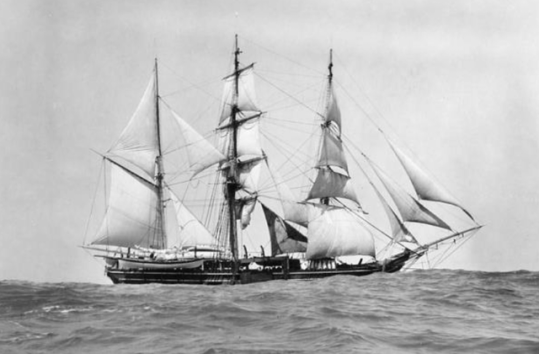
Photo of the bark Sunbeam hove to at sea, 1904, Clifford Ashley. Via New Bedford Whaling Museum.
Typically 19th century whaleships were three-masted ships or barks, and many ships were eventually re-rigged as barks in the latter half of the century as it required a smaller crew to handle. Whalers tended to be squat and broad, built for stability rather than speed. They were going to be at sea for years, with big cavernous holds for hundreds upon hundreds of barrels of oil, as well as equipment and provisions set to last many months without resupply. Thus, sturdiness was the primary focus in their design.

A cross section of the bark Alice Knowles from G.B. Goode's The Fisheries and Fishery Industry of the United States. Look at all that needed storage space!
With square sterns and a typical ratio of 1:4 for beam to length (as opposed to sleek merchant ships that often were more of a 1:6), describing them as a ‘tub’,--as many whalers grudgingly did when speaking of their floating home--is rather fitting (though perhaps a bit uncharitable). On average, whaleships were 100-115 ft in length, 25-30ft wide, with a tonnage ranging from 180-400.
They were built with few frills. Rarely did they have galleries or figureheads, instead having a simple billet-head or doing without the flourish entirely. My biggest indulgence was giving the Valor a bit more of an elegant prow, which I might regret a little bit since now I have to draw it all the time.
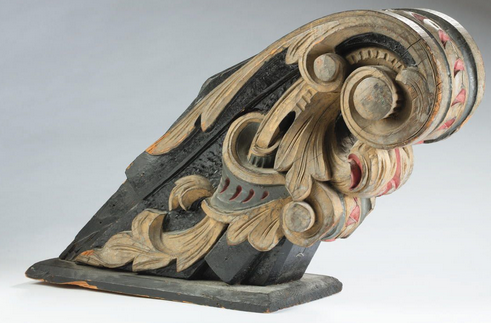
Billet-head vs figurehead...
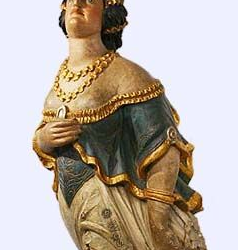
A distinct lack of fanciness!
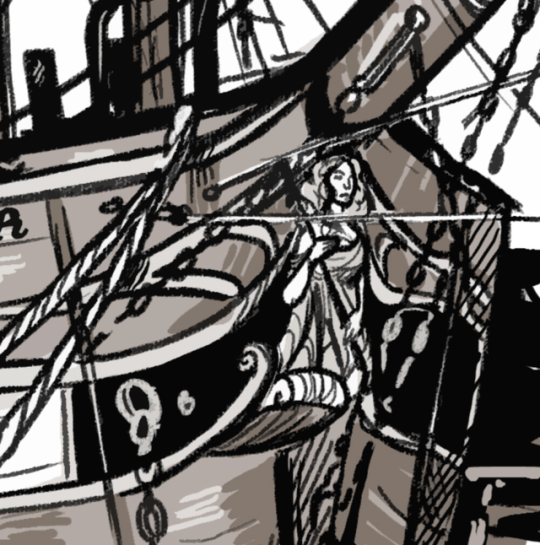
I wanted to draw a lady tho. The one of……three women in GTW. Does she count?
Sometimes whalers were painted with false gun ports along their hull, a traditional holdover from when they had to worry more often about wartime enemies in the late 18th century. The hope was that the paint job in combination with her chunky appearance would lead to her being mistaken for a small warship at a distance and thus spared harassment. Even when no longer really necessary, the design often made its appearance.
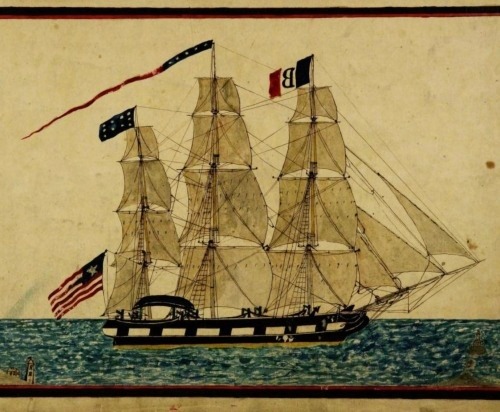
Drawing in the logbook of Captain James Coffin of his ship Washington, 1841.
I quite liked the look of the psuedo gun ports, and decided to give the Valor the same as an embellishment for some extra contrast.
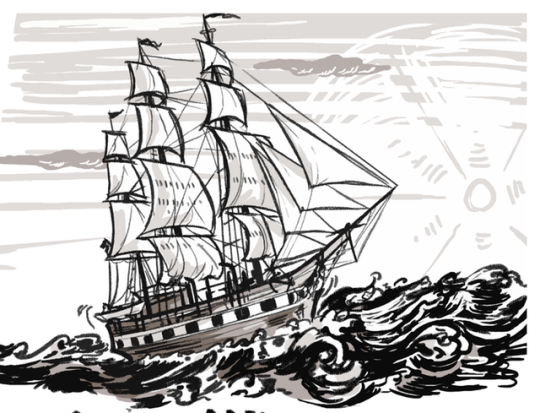
The most identifying feature of a whaler was the tryworks—a large brick oven with heavy iron pots located aft of the foremast and in front of the main hatch. They were built with a pen that would be filled with sea water that flowed freely beneath a checker-board laid brick base to keep the extreme heat from setting fire to the ship. The tryworks would have to be rebuilt for each voyage, so there was sometimes a rather joyous moment at the end of a long trip when the crew would tear the structure apart and toss it in the sea.
Along the port side, three whaleboats would be slung on the davits. Fore, aft, and amidships. A fourth whaleboat would be located on the starboard quarter.

Screenshot of my desktop background that's some deck plans of a whaleship cos I got sick of digging for the reference every time I had to spatially orient myself when drawing a panel!
Deckhouses were built aft to house the galley and storage lockers, and there was also a ‘hurricane house’ built over the helm to protect whoever was steering during foul weather. Spare whaleboats, as well as harpoons, spades, lances, and other whaling gear would be stored on top of this cover or on hanging shelves beneath it.
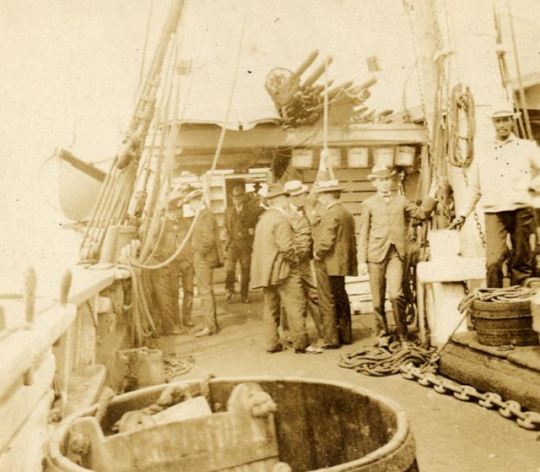
A view of whalers and the afthouse, on the bark Greyhound. Via NBWM.
The final identifying feature of a whaleship was a pair of cross trees, a platform with hoops at the top of the mast where men would be stationed to look out for whales.

The ship that I’ve referenced the most in my design of the Valor is, of course, the Charles W. Morgan because she can still be visited! The last surviving wooden whaleship, she had a long life of 37 voyages (and a couple movie roles in her sunset years) spanning from 1841-1921 (and one more voyage in 2014! Heartbreak of heartbreaks that I was not on it!). She’s now a crown jewel at the Mystic Seaport Museum. I was honored to meet her.
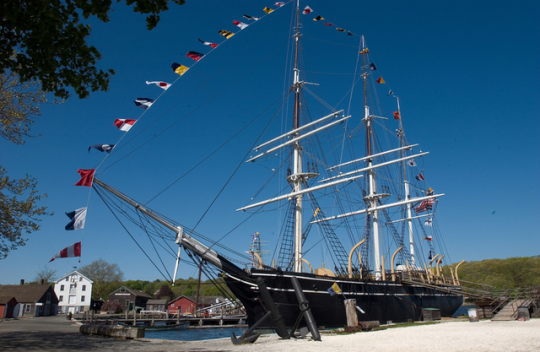
She had some lovely authenticating details that I was happy to put into my own worldbuilding, such as a reference to this gimballed bed. It was designed to always stay level even as the ship rolled, installed by one of the Morgan’s captains to try mitigating his wife's seasickness.
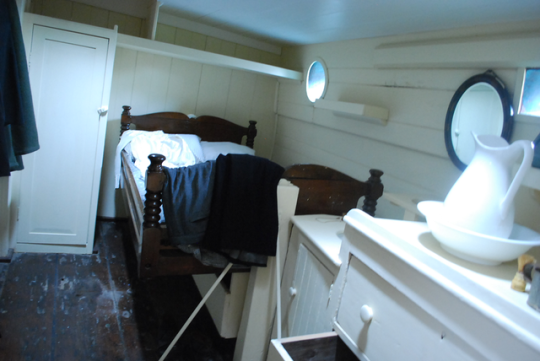

Another favorite detail of mine was how natural daylight was drawn into the cabins and forecastle via deck prisms. Set with their bases flush with the deck above, glass deck prisms were designed to bring light down below.
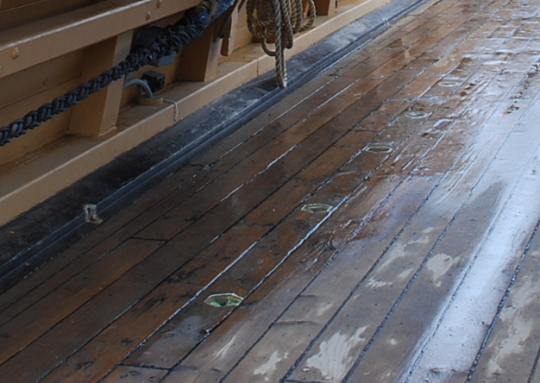
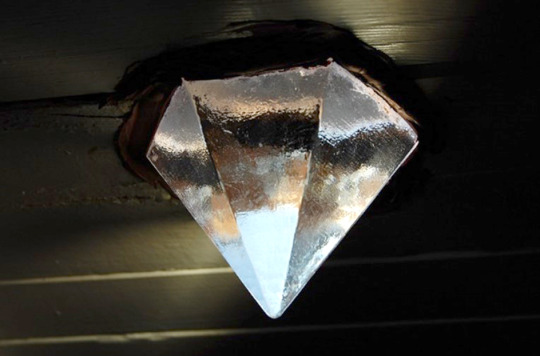
I remember being surprised at how effective they were. In the photo below, the yellow light is artificial, but the blue light is coming solely from the deck prism. This was on a dark rainy day.

As such, I really enjoy always thinking about how these prisms are lighting the areas below on the Valor.

During my visit I remember thinking that this old surviving whaleship looked quite comfortable and cozy.

Look at that.

Such homey little flourishes.
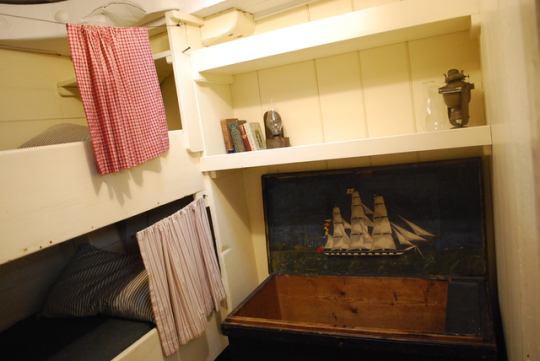
Look at how cute.
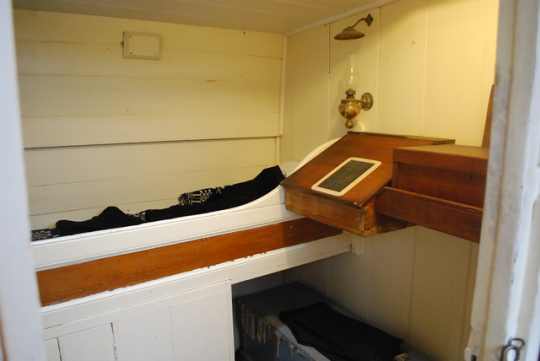
I’d live here.
That is, until I thought about the reality of this work and world. The fo'c'sle helped bring that reality forward. There wasn't anyone else on the ship and it was a cold spring day, but upon stepping into the space I could feel the humidity that had gathered there.

I could imagine the noise of it, the smell of it, the heaviness of the air that came with 20 men sharing such a space, eating and smoking in it, crushing cockroaches in it, dumping their wet gear in it, vomiting in it, keeping a communal urine barrel in it, reeking of blood and oil and smoke and ash as everything mouldered in the damp for for three to four years. The dimensions of the fo'c'sle was enough to set my imagination a’going. It was a perfect reference, and for the comic it just needed to be populated.
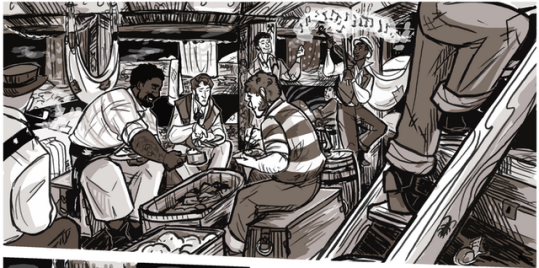
For the sake of having somewhat readable panels, my boys are lucky to have been given a much more spacious residence. But still, I try to build out the claustrophobia of the space. And this is just the first night. As time goes on, I’m looking forward to besmirching this place.
Superimposing the reality of a whaler was also necessary in drawing the decks (and will become even more so when I get to the whaling scenes). Now, as a museum, the ship is pristine...
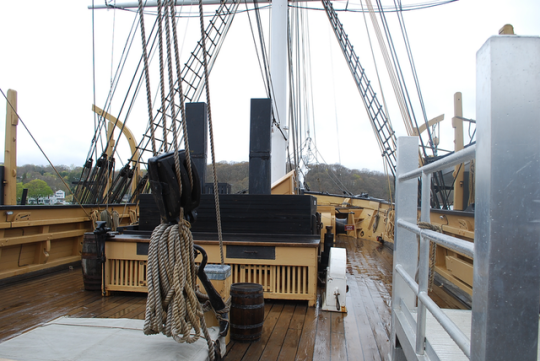
But I must always remember the description given by a 19th century whaler grumbling that while cutting in a whale, ‘everything is beshit’. Documentary footage as well as photographs, coupled with the words from dead men's journals and one’s own imagination of the hellishness of the work is how I begin to paint the decks of this whaler, especially during the work of cutting in.
(warning for sensitive images below of a lot of blubber)


Photos by William H Tripp, 1925. Via NBWM
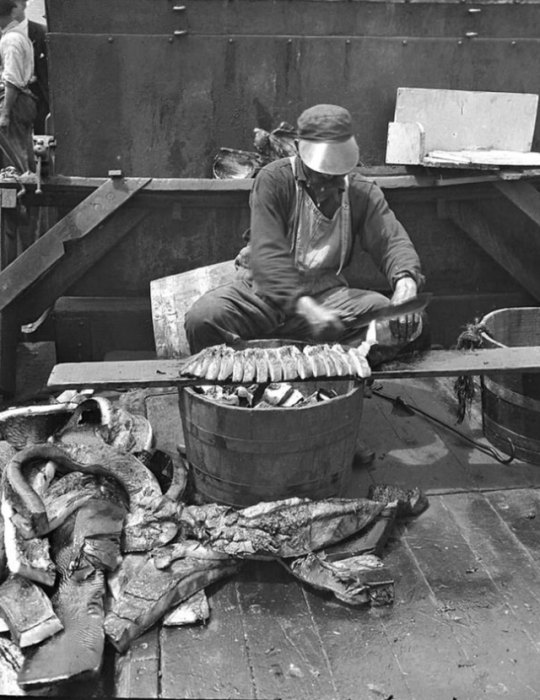
Photo by Albert Cook Church. NBWM.
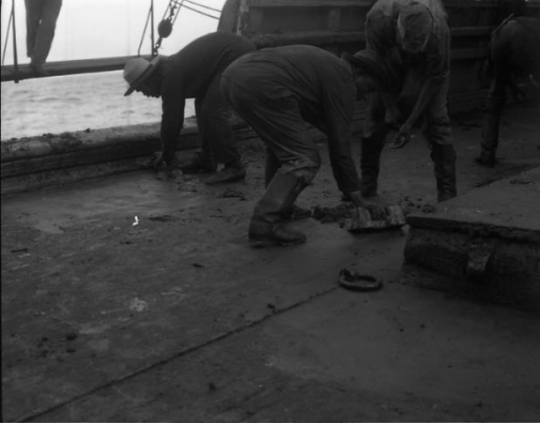
This 1904 image, as described by its photographer Clifford Ashley, 'Rectangular blocks of blubber (lippers) are used to scrape up bits of blubber and slush from the deck so nothing is wasted'. Via NBWM.
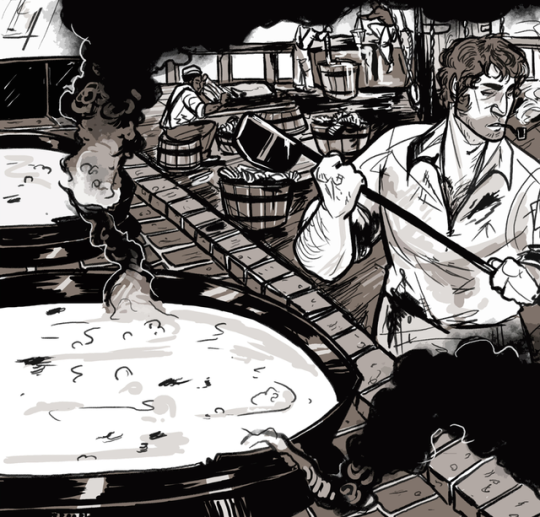
But the place that made me feel the closest sense of reality on the Morgan was the blubber room. The deck prisms didn’t reach here, and in some places the beams were so low I had to duck my head.
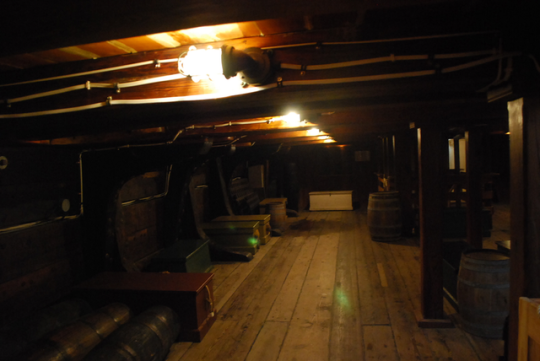
This was where large 15ft sheets of blubber would be dumped below via the hatch, for men to hack them up into smaller 6ft ‘horse pieces’ and then pitch them back up on deck to be further minced. I couldn’t help but think of the movement of the ship in the dark, of the slabs of blubber filling the space, slick with oil. I thought of how much oil would be tracked across the deck and how slippery it’d be, and how a man would have to keep his head cocked to one side for hours to work in there. I thought of how he would get to the fo'c'sle through the blubber room and how the work would be tracked all over the ship and find its way into every bunk. How it would be absolutely inescapable. I thought about the hot sick closeness of having no air down there, the heat from the tryworks radiating mercilessly from above, a crick in your neck, your double-edged boarding knife handle too slick.
Being there and overlaying that work within it was one of the closest times I felt to time travel. And as I try to make the Valor feel alive, to feel real, I always try to capture what I felt here in every panel, and push each one just a little more to get as close as I can to that place.
28 notes
·
View notes